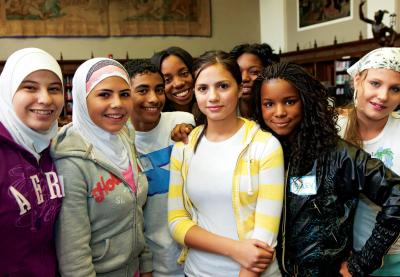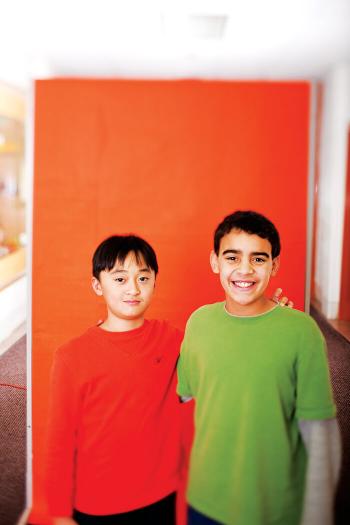The basketball players sit in a corner of the cafeteria.
The rockers hang out near the stage.
The ditchers and smokers congregate near the school gates.
The JV football players and cheerleaders? They’re near the field.
This is how students at California’s Hawthorne High described the typical lunch period at their school. In doing so, they also made the unspoken rule clear: Stick to your own kind.
But last fall, Hawthorne’s students broke out of their rigidly segregated habits. Why? They answered the call of Mix It Up at Lunch Day, a national event sponsored by Teaching Tolerance that asks students to break bread with someone new. This year’s Mix It Up at Lunch Day will be Tuesday, November 9.
“Cliques, even those seemingly based on interests or hobbies, often serve as a proxy for social and cultural differences,” said Lecia Brooks, Mix It Up’s national coordinator. “And when we allow ourselves to be fully separated from others, stereotyping and conflict can take shape.”
School conflict drew Los Angeles educator Jamie Diego Chavez to the Mix It Up program. “When I first started working here in 2005, I helped organize Mix It Up at Lunch Day to address increasing concerns about social and racial tensions—and to promote dialogue and better understanding among different groups.”
Chavez’s approach to the program has evolved to include not only the lunch activity—asking students to sit with someone new on Mix It Up at Lunch Day—but also intensive peer-run “discussion circles” beforehand that help students root out the intolerance and fear that sometimes fuels their separation.
A desire to make sure that every student belongs—or, in her words, are “seen”—drew Norma Harb, a social worker at Fordson High School in Dearborn, Michigan, to Mix It Up. She recalls walking by two African-American 11th graders and barely acknowledging them. Only later did she ask herself how those two students—anomalies inside a school where 90 percent of students are of Middle Eastern descent—might be faring. “How many students are invisible?” she asked. “How can we make the invisible visible?”
To answer that question, Harb pulled together a committee of teachers and students to organize. On Mix It Up at Lunch Day, students sat down to lunch with people who were not in their usual social circles and played a game to help get conversations started. One person had to tell two truths and one lie. Their new lunch mates had to guess which statement was false.
“[We] had a lot of fun,” Fordson junior Omar Nasrallah said. “And some walked out with friends they didn’t have before.”
For Harb, the day wasn’t just about fun. It was also about creating a community where every student was seen and engaged by peers.
“Black, white, Arab, non-Arab, bilingual, special education, jocks, musicians—it didn’t matter,” she said. “What did [matter] at that time was a group of human beings enjoying lunch, and taking a leap of faith in communication and bonding.
“One huge score for humanity,” she said.
Seven Steps to Mixing It Up
How can you make this year’s Mix It Up at Lunch Day—November 9—a success? The following tips and ideas come from the 2009-2010 “Mix It Up Model Schools,” honored for their exemplary, sustained efforts to create welcoming and inclusive environments.
Make the commitment.
Educators at Brunson Elementary School in Winston-Salem, North Carolina, first committed to Mix It Up in 2006. “The students are engaged in different curriculums—part of our school is a magnet for the highly academically gifted—and [they] rarely have the opportunity to mix,” explained assistant principal Andy Lester-Niles. “We saw the need to intentionally provide time for kids to interact and feel part of the larger Brunson community. Mix It Up fit beautifully.” At Brunson, Mix It Up is woven into class projects and its themes extend throughout the school year.

Identify the divisions in your school.
Ask students to share their experiences of exclusion as a way to build support for the event. At California’s Sierra Vista Junior High School, students wrote short stories about personal injustices on red paper “bricks” that were then assembled into a wall. On Mix It Up Day, students tore the wall down by removing bricks and sharing during the school-wide reading period. Many schools made use of the Mix It Up survey.
Promote the event.
Students need to know—ahead of time—what they’ll be invited to do and why it’s important. Schools in the William S. Hart Union High School District in California used video announcements and displays on school welcome signs. Other schools created their own posters and fliers.
Conduct supportive activities beforehand.
At North Hills Elementary in York, Pennsylvania, educator Clydiene Liverman asked students to think about the ways they sometimes put other students down. She then asked them to brainstorm “put ups,” or words and phrases that lift someone up. The “put ups” were later placed on tables during Mix It Up at Lunch Day. “Each student got to keep a put-up as a reminder,” she said. “A reminder that someone else in their school family has something nice to say, and [a reminder] to use put-ups, not put-downs.”
Take action on national Mix It Up at Lunch Day.
At Northley Middle School in Aston, Pennsylvania, organizers moved cafeteria tables around and used playing cards to mix students up. “We also gave them conversation starters attached to balloons and had them play a game called the ‘name/symbol’ game,” said counselor Kevin S. Siegel. “They had to go around the table and say everyone’s name and introduce their symbol (a gesture). They earned prizes—and loved it!” Meanwhile, at California’s Valencia High School, each class received a set of Popsicle sticks, and, in a “human scavenger hunt,” students had to locate someone from another class with a matching word written on the stick.
Reflect on the lunch activity.
Request three minutes of class time for students to write on prompts such as, “Today’s lunch activity showed me that. ...” Allow time for teachers to share what they observed or experienced in faculty meetings, too. Use this feedback to inform additional efforts.
Follow up.
Use national Mix It Up at Lunch Day to launch a year-long campaign to make the school inclusive and welcoming for all students. Rogers Park Elementary, in Anchorage, Alaska, holds “Mix It Up Mondays” every week, using a wide array of table grouping themes, from peace symbols to Dr. Seuss characters. “Our students are learning more about each other and continue to build a stronger learning community through Mix It Up,” reported Erika Crumley, the school’s Social Emotional Learning specialist. Back at Brunson Elementary, “mixed up” student teams work collaboratively on service-learning projects throughout the school year, from a Valentine’s Day project that “shares the love” through a book drive for a sister school in Botswana to an environmental project with a local grocer on Earth Day.


